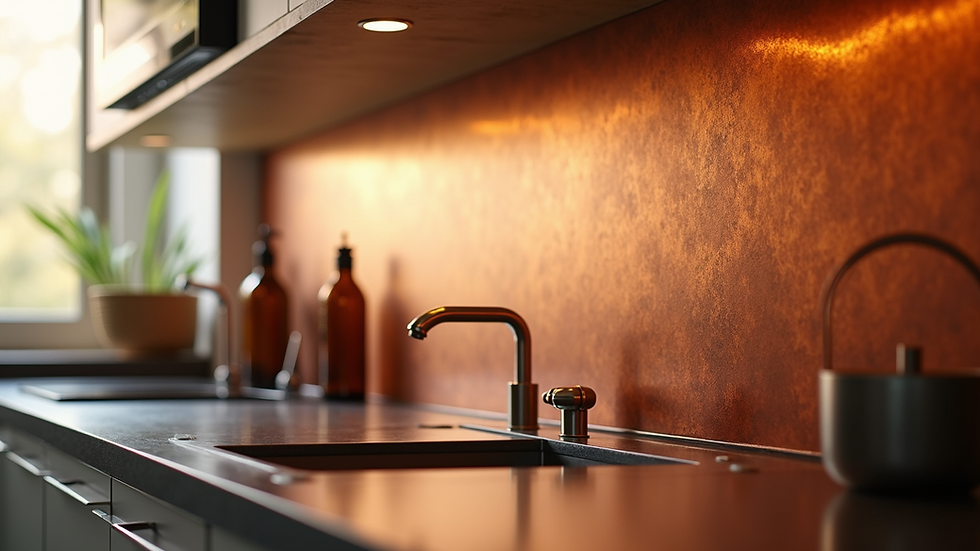Exploring the Artistry of Handcrafted Copper Creations
- Tracy Bumgarner
- Jun 23
- 4 min read
Handcrafted copper creations embody a unique blend of artistry, tradition, and utility. They have been cherished for centuries not only for their aesthetic appeal but also for their durability and versatility. This blog post delves into the rich world of handcrafted copper, exploring its history, various applications, and the intricate techniques involved in its creation.
The Allure of Handcrafted Copper
Copper is one of the oldest metals known to humanity, with its use tracing back to ancient civilizations. The charm of handcrafted copper lies in its warm, reddish-brown hue and its ability to develop a beautiful patina over time. Every handcrafted piece tells a story, reflecting the skill and creativity of the artisan behind it.

The rise of modern craftsmanship has witnessed a resurgence in the appreciation of handcrafted items. Unlike mass-produced goods, handcrafted copper pieces offer a level of detail and personalization that machine-made products cannot replicate. Each item is unique, with imperfections that often enhance its character and charm.
Crafting Techniques and Processes
The process of creating handcrafted copper items involves a variety of techniques, including hammering, embossing, and patination. Artisans often start with raw copper sheets or rods, which they manipulate using traditional hand tools.
Hammering: This technique, known as raising, involves striking the copper with a hammer to shape it into desired forms. This method not only shapes the metal but also strengthens it, making each piece robust and lasting.
Embossing: Through embossing, artisans create intricate designs by pressing patterns into the copper. This adds texture and depth, transforming a plain surface into a captivating work of art.
Patination: The final touch often involves patination, where a chemical solution is applied to accelerate the natural aging process. The result is a stunning array of colors, from deep blues to rustic browns, that enhance the piece's visual appeal.

These techniques not only highlight the skills of the artisans but also the individuality of each piece. Unlike mass production, where uniformity reigns, handcrafted copper items have a soul, making them highly sought after.
Applications of Handcrafted Copper
Handcrafted copper creations serve a multitude of purposes, from functional household items to exquisite decorative art. Here are a few popular applications:
Cookware: Copper pots and pans are known for their excellent heat conductivity. Chefs often prefer copper cookware because it enables precise temperature control. Handcrafted copper cookware combines functionality with beauty, making them a staple in gourmet kitchens.
Home Décor: Custom copper designs can enhance any living space. From sculptures and wall hangings to light fixtures, handcrafted copper items bring warmth and character to home décor. A well-placed copper piece can serve as a focal point, attracting the admiration of guests.
Jewelry: The creativity of artisans shines through in handcrafted copper jewelry. Earrings, bracelets, and necklaces made from copper often feature intricate designs and unique shapes, making each piece a conversation starter.

The Environmental Impact of Handcrafted Copper
In today's age of sustainability, handcrafted copper is an environmentally friendly choice. Copper is durable, ensuring long-lasting use, which reduces waste. Furthermore, it is recyclable. Broken or unwanted copper items can be melted down and reformed into new products, minimizing the environmental footprint.
Handcrafted items typically follow sustainable practices. Artisans often use locally sourced materials and traditional techniques that reduce reliance on industrial processes. By choosing handcrafted copper creations, consumers support local artisans and help sustain traditional crafts, preserving cultural heritage.
Where to Find Handcrafted Copper Creations
Finding authentic handcrafted copper items can be an exciting adventure. Many artisans showcase their work at local craft fairs, farmer's markets, and artisan shops. Online platforms also provide an avenue for discovering unique pieces:
Artisan Websites: Websites dedicated to handmade items often feature a variety of artisans. Look for those focusing on handcrafted copper to explore diverse offerings.
Social Media: Platforms like Instagram and Pinterest allow you to follow artisans and their work. Engaging with these artists can lead to discovering custom copper designs that perfectly fit your style.
Local Workshops: Participating in workshops or classes can connect you with artisans directly. Not only do you get to learn about the craft, but you also gain insight into the craftsmanship behind each piece.
Preserving and Caring for Handcrafted Copper
To ensure your handcrafted copper creations maintain their beauty, proper care is essential. Here are some tips to keep them looking their best:
Cleaning: Use a mild soap and warm water to clean copper items. Avoid abrasive cleaners that can scratch the surface. For stubborn tarnish, a mixture of vinegar and baking soda can work wonders.
Storage: Store copper pieces in a dry place to prevent moisture build-up, which can lead to tarnishing. For jewelry, consider an anti-tarnish cloth to wrap delicate pieces.
Avoiding Scratches: Keep copper items away from sharp objects that can mar their surface. Use soft cloths when handling them to preserve their finish and shine.
Closing Thoughts on Handcrafted Copper Creations
The artistry of handcrafted copper creations not only showcases the skill and passion of artisans but also enriches our lives with beauty and functionality. Whether you choose a stunning piece for your home, durable cookware for your kitchen, or unique jewelry, these handcrafted items embody a rich tradition of craftsmanship.
The blend of tradition, sustainability, and artistic expression makes handcrafted copper truly special. As you explore this fascinating world, consider supporting local artisans and choosing handcrafted pieces that resonate with your own personal style. Each creation is more than just an object; it is a part of history that deserves a place in our modern lives.










Comments